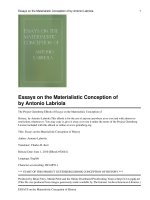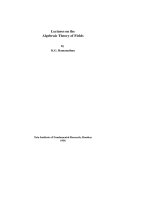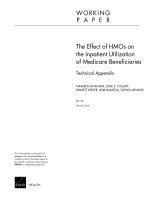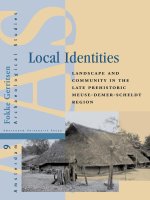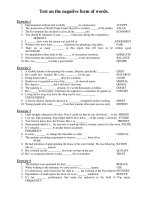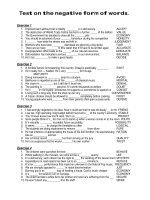Explorative analysis on the mortality pattern of wild animals at territorial forest division Jabalpur, India
Bạn đang xem bản rút gọn của tài liệu. Xem và tải ngay bản đầy đủ của tài liệu tại đây (231.06 KB, 7 trang )
Int.J.Curr.Microbiol.App.Sci (2019) 8(1): 2247-2253
International Journal of Current Microbiology and Applied Sciences
ISSN: 2319-7706 Volume 8 Number 01 (2019)
Journal homepage:
Original Research Article
/>
Explorative Analysis on the Mortality Pattern of Wild Animals at
Territorial Forest Division Jabalpur, India
Ranjeet Harne*, Somesh Singh, Amol Rokde and Devendra Podhade
School of wildlife Forensic and Health, NDVSU, Jabalpur – 482001, MP, India
*Corresponding author
ABSTRACT
Keywords
Mortality pattern,
Free range, Rescue,
Territorial Forest
Division
Article Info
Accepted:
14 December 2018
Available Online:
10 January 2019
A study was conducted to know the mortality pattern in wild animals received from rescue
teams in Non Protected Areas of Territorial Forest Division Jabalpur, Madhya Pradesh. A
total of 104 deaths were recorded in seventeen different species of wild animals during the
period from April 2015 - March 2017. The cause specific mortality was determined on the
basis of data available from primary and secondary resources. The history and pathoanatomical changes observed at necropsy were recorded among animals brought at the
School of wildlife Forensic and Health, NDVSU, Jabalpur, MP, India. The prime cause of
deaths among wild animals were traumatic shock (42.31%), followed by respiratory failure
(15.38%), drowning (13.46%), hypovolemic shock (3.85%), lung oedema (1.92%) and
septicaemia (1.92%), while capture myopathy, electrocution and heat stroke were also
reported each at the level of (0.96%). Remaining 18.27% of the carcasses showed autolytic
changes. It is necessary to conduct periodic studies on the mortality pattern among wild
animals to know the factors affecting their survival and take steps to prevent large scale
morbidity and mortality. The study also emphasises the significance of scientific handling
during rescue operations in prevention of animal mortalities at Territorial Forest Divisions.
Introduction
The wild animals and plants are important
constituents of ecosystem and are essential to
maintain equilibrium of various natural
processes like temperature, rainfall, soil
fertility etc. Uncontrollable human population
growth leading to the industrialization and
urbanization is rapidly replacing natural
habitat, local vegetation and decreasing free
space for wild animal’s day by day (Donald
al., 2004). This inter-specific competition for
resources between human and wild animals
has caused a decline in population of free
range wild animals. The growing livestock
population has created a competition for feed
and fodder by overgrazing surrounding forest
area causing a local decline in the population
of wild herbivores (Mishra et al., 2003). The
seasonal variation also causes a change in
their diet and prey so these wild animals move
from one place to other in search of prey
which exposes them to two different adverse
conditions like road accidents and humanwildlife conflict leading to more mortality of
animals (Patterson et al., 2004).
2247
Int.J.Curr.Microbiol.App.Sci (2019) 8(1): 2247-2253
Wildlife mortality due to chasing by dogs,
injury, felling in canal, heat stress and road
accidents have caused considerable damage to
their population in non protected areas in the
past years. The condition is more critical in
and around non protected areas of developing
urban settings. Unfortunately, systemic studies
on the mortality pattern in non protected areas
are scarce and those available focused
primarily on a few large mammals.
Nevertheless, many species are found as
victims and their mortality is probably
underestimated. The analysis on mortality
pattern in free range wild animal population is
bit challenging because most such deaths go
unobserved. Moreover, it is also difficult to
diagnose the cause of mortality, weather it is
natural or due to unnatural factors. Therefore,
the present study was conducted to explore the
mortality pattern and causes of deaths among
wild animals received from rescue teams at
Territorial Forest Division Jabalpur.
Materials and Methods
The study area Jabalpur is located in the
Mahakoshal region of Madhya Pradesh, India
and geographically, located between latitude
23o 10' N and 23o 17'N and longitude 79o 57'E
and 79o 95'E. The work was carried in
Territorial Forest Division Jabalpur during
April 2015 - March 2017. The cause of death
of animals died during this period was
determined based on necropsy examination.
Data were also collected from the primary
resources (Singh and Sharma, 2011) and
secondary resources (Cnossen, 1997). The
necropsy examination and analysis of data was
conducted at the School of Wildlife Forensic
and Health, NDVSU, Jabalpur, MP, India.
Results and Discussion
Present study analyses a total of 104 death
cases of wild animals out of which maximum
deaths occurred due to traumatic shock
(42.31%) followed by respiratory failure
(15.38%), drowning (13.46%), hypovolemic
shock (3.85%), lung oedema (1.92%) and
septicaemia (1.92%), while capture myopathy,
electrocution and heat stroke were reported
each at the level of (0.96%). Autolytic
changes were reported in (18.27%) of the
carcasses (Table 1, Fig. 1 and Plate 1).
Deaths of pariah kite, pangolin, porcupine,
black buck and tigress cub were reported due
to traumatic shock. The death of 2 leopards
was reported due to respiratory failure, while
autolytic changes were recorded in other 2
carcasses. The necropsy of 3 cobras revealed
their deaths due to respiratory failure.
Carcasses of a sand boa and a crocodile were
putrefied and showed autolytic changes.
Traumatic shock and electrocution were the
causes of mortality in common langur. Among
peafowl the mortality was reported due to
traumatic shock in 2 and lung oedema in 1;
while autolytic changes were reported in 1
carcass.
The necropsy findings in chital showed
maximum percentage of animals dying due to
traumatic shock (50.88%) followed by
respiratory failure (14.04%), hypovolemic
shock (7.02%), drowning (3.51%); capture
myopathy, lung oedema, septicaemia and heat
stroke each three at the level of (1.75%); while
17.54% of the carcasses showed autolytic
changes.
The necropsy findings in barking deer showed
maximum animals dying due to traumatic
shock (50%), followed respiratory failure and
drowning each at the level of 16.67%; while
autolytic changes were reported in 16.67% of
the carcasses. Death of sambhar was reported
due to traumatic shock (50%) and respiratory
failure (50%). Septicaemia was recorded in
carcass of a nilgai. Traumatic shock (25%)
and autolytic changes (75%) were seen in wild
boars (Table 1, Fig. 1 and Plate 1).
2248
Int.J.Curr.Microbiol.App.Sci (2019) 8(1): 2247-2253
Table.1 Mortality pattern in wild animal during 2015-17
S.
No
Species
1.
2.
3.
4.
5.
6.
7.
Chital
Barking deer
Black buck
Sambar
Nilgai
Wild boar
Rhesus
macaque
Common
langur
Peafowl
Pariah kite
Pangolin
Porcupine
Crocodile
Tigress (cub)
Leopard
Cobra
Sand boa
Grand Total
8.
9.
10.
11.
12.
13.
14.
15.
16.
17.
Traumatic
shock
No. (%)
29 (50.88)
03 (50)
01 (100)
01 (50)
01 (25)
-
Respiratory
Failure
No. (%)
08 (14.04)
01 (16.67)
01 (50)
01 (8.33)
Hypovolemic
Shock
No. (%)
04 (7.02)
-
Capture
myopathy
No. (%)
1 (1.75)
-
Autolytic
changes
No. (%)
10 (17.54)
01 (16.67)
03 (75)
-
Drowning
No. (%)
01 (50)
-
-
-
02 (50)
01 (100)
03 (100)
01 (100)
01 (100)
44 (42.31)
02 (50)
03 (100%)
16 (15.38)
04 (3.85)
01 (0.96)
Septicaemia
No. (%)
Electrocution
No. (%)
02 (3.51)
01 (16.67)
11 (91.67)
Lung
oedema
No. (%)
01 (1.75)
-
01 (1.75)
01 (100)
-
-
-
-
01 (25)
01 (100)
02 (50)
01 (100%)
19 (18.27)
14 (13.46)
01 (25)
02 (1.92)
2249
Total
Number
-
Heat
stroke
No. (%)
01 (1.75)
-
-
01 (50)
-
02
02 (1.92)
01 (0.96)
01 (0.96)
04
01
03
01
01
01
04
03
01
104
57
06
01
02
01
04
12
Int.J.Curr.Microbiol.App.Sci (2019) 8(1): 2247-2253
Fig.1 Necropsy changes in wild animals recovered during rescue operation (2015-2017)
2250
Int.J.Curr.Microbiol.App.Sci (2019) 8(1): 2247-2253
(a)
Plate.1 Necropsy examination of wild animals
Extensive hemorrhages in medial aspect of neck region due to severe trauma in a chital
(b)
Dog bite injuries in perineum and medial aspect of thigh in a chital
(c)
Congestion in respiratory tract of a cobra
(a)
(b)
(c)
2251
Int.J.Curr.Microbiol.App.Sci (2019) 8(1): 2247-2253
Among animals died while being brought for
treatment, the unscientific transportation,
improper handlings leading to skin abrasion,
lacerations, muscular injury, hoof injury, antler
injury, strangulation due to strings and fracture
were
recorded.
During the
necropsy
examinations major lesions reported were skin
abrasions, lacerations, subcutaneous congestion,
haemorrhages, muscular injuries, fractures and
haemothorax. The findings of the investigation
of Swamy et al., (2016) reports most of the
mortalities in free ranging wild animals due to
respiratory failure resulting from road trauma,
drowning, suffocation and strangulation.
Similar kind of studies was conducted by
Kumar et al., (2012) on the mortality causes in
113 wild animals died at Shivalik hills in
Himachal Pradesh. The necropsy findings
revealed musculoskeletal injuries in 68.14%
(77); more specifically fractures 37.16% (42)
and fatal traumatic injuries 30.97% (35) as most
common cause of mortality in all the animals.
Mortality due to septicemic conditions was
observed in 8.84% (10) of died animals.
Obendorf (1983) conducted necropsy of 44 wild
koalas (24 males and 20 females) from several
locations in Victoria, Australia and the
commonest reason of deaths were traumatic
injuries resulting from motor vehicle accidents
and intra-specific conflict. The strong
association between wild animals, human
beings and domestic animals has become
important now-a-days as there was found
involvement of wild animals in transmission of
certain inter-species as well as intra-species
diseases.
Acharjyo and Rao (1987) documented the
rescue cases in and around Biological Park,
Bhubaneshwar which reports mortality due to
animal chasing by dogs followed by falling into
moat. The authors also reported 4.3% mortality
during rescue due to drowning in a period of
five year. Arora (2003) proposed the chance for
variation in health status from normal range due
to capture stress i.e. chemical immobilization,
nutritional and health status. The former factor
is difficult to be eliminated and depends mostly
on the nature of habitation (wild, semi-captive,
captive) and the extent of domestication.
Among rhesus macaques maximum percentage
of animals died due to drowning (91.67%),
followed by respiratory failure (1.75%). The
necropsy findings in common langur showed
equal percentage of animals dying due to
traumatic shock and electrocution with each at
the level of (50%). Sengar et al., (2014)
reported a case of electrocution injury in a
common langur wandering in search of food
and water. They proposed that electric current
passing through the animal body may cause
coma and death, if the current is sufficiently
strong. Nath and Chakraborty (2013) reported
27 deaths in six different species of non human
primates.
The necropsy findings in a pariah kite showed
death of the bird due to traumatic shock. Arora
(2003) emphasized that capturing wild birds
causes injury, shock and death in millions each
year. He further stressed that transportation of
birds is not risk free particularly during
summers.
It is the general behaviour of an animal to
escape while being captured. However, deer are
at high risk of stress, shock and capture
myopathy while they are being handled prior to
their transport from one place to another. The
risk increases if the deer with antlers or in
velvet are allowed to struggle during their
capture or restraint and the process is carried
out in hot weather. The study findings were
indicative of various kinds of injuries and
stressful conditions animals suffer during rescue
operations, which can be improved through
scientific handling and transportation of
animals.
In conclusion, the study signified that the
analysis on mortality pattern of wild animals at
Territorial Forest Divisions is of utmost
importance to reveal the factors affecting
animal survival, so as to take measures to
prevent large scale morbidity and mortalities
and ensure effective wildlife conservation. For
2252
Int.J.Curr.Microbiol.App.Sci (2019) 8(1): 2247-2253
this purpose it is important to perform scientific
necropsy examination of each wild animal to
know the causes of deaths and take
precautionary measures to prevent large scale
mortalities. Lack of proper handling of animals
could lead to animal mortalities. The success of
rescue operations depends chiefly upon the
scientific handling of animals which not only
avoid distresses in wild animals but also prevent
mortalities. It is need of the hour to prepare and
adopt standard operating procedures for rescue
and handling of wild animals at Territorial
Forest Divisions and develop trained human
resources for handling such situations.
Acknowledgement
Authors are thankful to the authorities of M.P.
Forest Department and Nanaji Deshmukh
Veterinary Science University, Jabalpur for
providing necessary support to carry out this
research work.
References
Acharjyo, L.N. and Rao, A.T. (1987). Mortality
pattern in some Indian captive wild
ruminants. Ind. J. Ani. Sci., 57: 430-435.
Arora, B. M. (2003). Indian Wildlife Diseases
and Disorders, 1st Edn., Bytes and Bytes
Printing, Bareilly, pp 449-581.
Cnossen, C. (1997). Secondary Research:
Learning Paper 7, School of Public
Administration and Law, the Robert
Gordon University, Aberdeen, United
Kingdom.
Donald, L.B., Kelly, A. D. (2004). Morbidity
and mortality of urban wildlife in the
Midwestern United States, Proceedings of
4th
International
Urban
Wildlife
Symposium. Online: zona.
edu/ pubs/adjunct/snr0704/
Kumar, V., Kumar, V and Raj, A. (2012).
Mortality in free range rescued wild
animals of Shivalik Hills in Himachal
Pradesh, India. Vet. Sci. Dev., 1(2): 4-6.
Mishra, C., Allen, P., McCarthy, T. (2003). The
role of incentive programs in conserving
the Snow Leopard. Con. Bio., 17:151220.
Nath, B.G. and Chakraborty, A. (2013)
Mortality pattern in non human primates
in Assam, India. Vet. World 6(1): 39-41.
Obendorf, D.L. (1983). Causes of mortality and
morbidity of wild koalas, Phascolarctos
cinereus (Goldfuss) in Victoria, Australia.
J of Wild Dis, 19(2): 123-131.
Online
/>research /material/resmeth
Patterson, B. D., Kasiki, S. M., Selempo, E. and
Kays, R. W. (2004). Livestock predation
by lions (Panthera leo) and other
carnivores on ranches neighboring Tsavo
National Park, Kenya. Bio Con., 16:
119:507.
Sengar, A., Shrivastav, A.B., Rokde, A. and
Singh,
S.
(2014).
Electrocution
management in a Langur (Semnopithecus
entellus). J of Wild Res, 2(1): 7-8.
Singh, R. and Sharma, R. K. (2011). Statistical
Methods and Experimental Design, 1st
Edn. Aman Publishing House, Meerut,
pp13-19.
Swamy, M., Rajput, N., Jadhav, K.K., Joshi,
H.R and Shrivastav, A.B. (2016).
Histopathology of asphyxia in free
ranging wild animals. In: National
Symposium on Innovative approaches for
Diagnosis and Control of Emerging and
Re-emerging diseases of Livestock,
Poultry and Fish, Anjora, 9-11 Nov.
2016, Indian Association of Veterinary
Pathologists (IAVP), p. 285.
How to cite this article:
Ranjeet Harne, Somesh Singh, Amol Rokde and Devendra Podhade. 2019. Explorative Analysis on
the Mortality Pattern of Wild Animals at Territorial Forest Division Jabalpur, India.
Int.J.Curr.Microbiol.App.Sci. 8(01): 2247-2253. doi: />
2253

